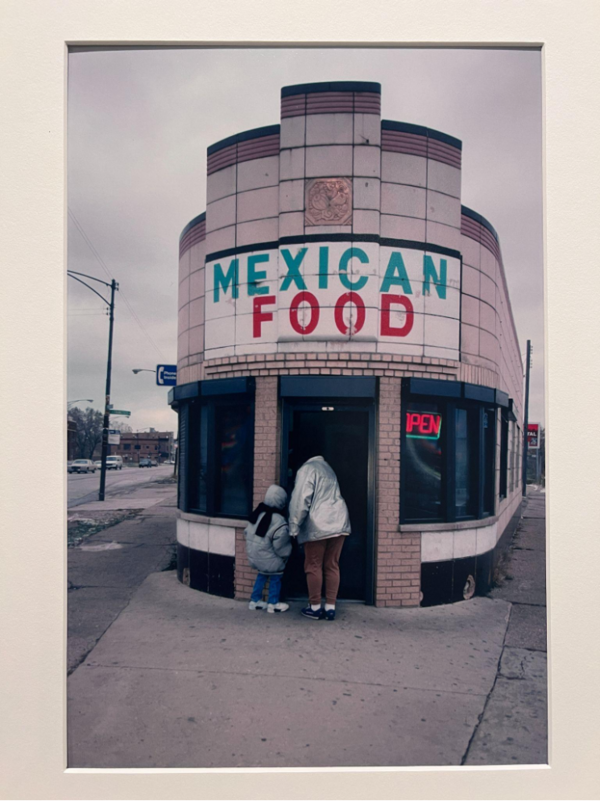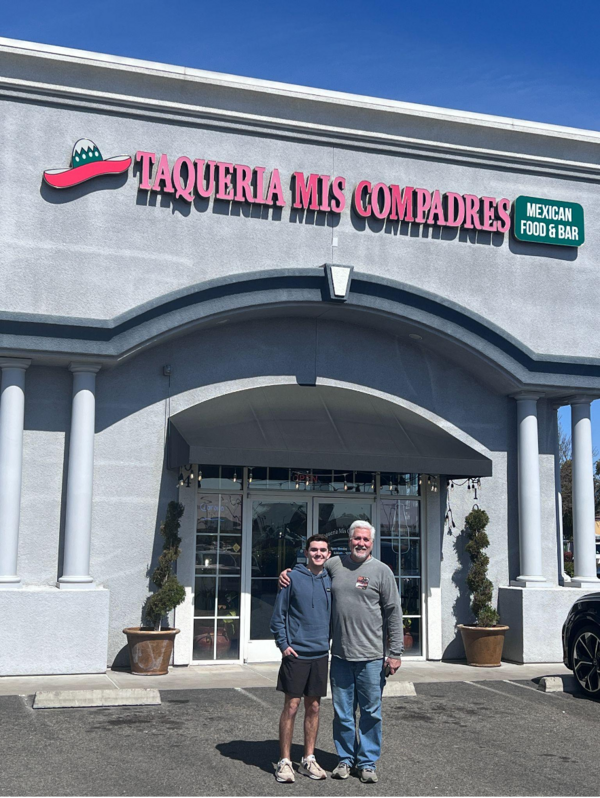
She’s tired of it. She can’t take any more of the dreadful complaints so she falls victim to his demands. Instead of walking straight back home from daycare, a point that mom emphasizes over and over again, she takes her son to escape the cold (and whining) and orders a bean and cheese burrito from the nearby, conveniently named restaurant. They walk in and are greeted by name with the owner welcoming them back once again. After an obviously delicious meal, mom and her son head to the door as the workers shout out hopes they’ll return, which everyone knows is sure to happen. Although annoyed at first, mom is satisfied with her meal and enjoys this time sharing a burrito with her son. Being only a few blocks down from home, this restaurant couldn’t have been better located. In their eyes, and presumably those of many others, experiences like these showcase the positive aspects of city life, despite the critical views of some outsiders including those of some governmental agencies. These negative views of urban life proved to be detrimental to the development of many city neighborhoods in the decades after World War II. At the same time, the negative effects of urban demographic change and failed government policies were countered by the positive aspects of even poor urban neighborhoods. These include the cultural vibrancy of the city and the positive aspects of urban community outlined by Jane Jacobs, all of which can be observed through the restaurant and its surroundings.
Taken in 2000, photographer Camilo José Vergara captured a photo of what appears to be a young boy and woman escaping the cold through a corner Mexican restaurant located on Grand and Chicago Ave in the Humboldt Park district of Northwest Chicago. It’s safe to assume that the people in his photo have a familial relationship and the scene creates a sense of embrace accomplished through the “open” sign, but also through the restaurant name itself—“MEXICAN FOOD”—which, in bold letters, implies a family-owned local restaurant, into which these two diners are eager to enter. The viewer cannot see inside the restaurant but possibly, through firsthand experience, can imagine the sweet sights and smells of a local taqueria. The building itself appears to be somewhat depreciated, which counterintuitively adds to the feeling that the taqueria is family-owned and operated. To the sides and behind the building appears to be a bustling community, with a busy street and multiple businesses including what looks like a car rental shop. Despite a positive first impression of a welcoming taqueria in a typical urban space, the Humboldt Park district had been expected by many to decline, raising questions as to why such government assertions were placed on a neighborhood.
The Home Owners Loan Corporation (HOLC), created in 1933, devised a system of mortgage relief and standardized real estate appraisal. Through their appraisal rating system, the HOLC separated neighborhoods into colored categories, A through D, placing value on each neighborhood based on the physical deterioration of buildings, the age and use of buildings, and especially on the demographics of the residents of the neighborhood (Jackson 197-198).
The district of Humboldt Park, in which this restaurant is located, received a grade of C, or “definitely declining.” In their review of the neighborhood, the HOLC cited the “age, obsolescence, and general appearance” of the buildings and it was “rated minus because of its mixed character and doubtful future” (Nelson et al.). In accordance with HOLC methods, Humboldt Park was negatively rated because 75% of the population was made up by white European families at the time of the appraisal in March of 1940, with the largest ethnic groups being Italians, Poles, and Russian Jews. The consequences of this poor HOLC rating meant this district did in fact undergo demographic change, with increased crime and a decline of property values, all of which the HOLC faulted.
In 1960, this district was still 99.1% white, with the majority of this percentage made up of white Europeans that the HOLC had cited. In the following decades, this number drastically decreased. Due in part to white flight and the coinciding influx of Puerto Ricans, by 1980 Humboldt Park’s population was about 70% Latino and African American (Eng). As of the 2020 Census, this percentage rose to 88.5%, with 55.4% of the total population made up of Latino residents (Community Data Snapshot). Along with this change in demographics, an increase in crime, especially gang-related, was observed. Of the seventy-seven community areas analyzed in a study of Chicago street gang crimes by the U.S. Department of Justice Office of Justice Programs, Humboldt Park was in the top two of “a mean annual rate of street gang-motivated crimes (381.5)” (Block and Block) from 1987 to 1990. In response to these changes in demographics and crime, property values in the Humboldt Park district decreased. This decline that the HOLC predicted and facilitated through its rating system doesn’t prove this community to be what these seemingly convincing characteristics imply it to be. Instead, the prosperity of this area is seen in the neighborhood’s culturally rich community, in its fulfillment of Jane Jacob’s vision for a good neighborhood, and the everyday experiences created by businesses like the one captured in the photograph.
As Humboldt Park became increasingly Puerto Rican in the 1970s, new residents brought cultural traditions that continue to be celebrated today. Recognized as the center of a prominent community, the neighborhood’s Puerto Rican population shares their culture, arts, and values through the National Museum of Puerto Rican Arts and Culture and an annual festival. This includes a parade followed by a carnival with traditional foods and cultural art that is also seen throughout the neighborhood. Many streets serve as host to murals that share stories of the community, including the hardships residents have faced over the years. While often associated with its strong Latino community, the neighborhood is also recognized as “a diverse community where a variety of cultures blend together” (“The History of”), including African-Americans and Ukrainian-Americans.
The rich Latin culture of the neighborhood helps explain the presence of the local taqueria, which has undergone some changes since it was photographed. The restaurant is now Taco El Jaliscien, and the presumed car rental shop is no longer in service as of a 2021 recording by Google Earth. The surrounding area not visible in the picture encompasses both residential and commercial space, as well as public space such as the near 200-acre Humboldt (Alexander Von) Park, which is about a third of a mile away from Taco El Jaliscien. These aspects of the community would conform to the ideals of Jane Jacobs, who “argued that, like streets and parks, successful commercial neighborhoods must have a strong diversity of business uses” (Wooten). The Mexican restaurant is surrounded by a mechanic, feed store, and even parking for engineers and police of the Metra building. Just a street over is space occupied by residential buildings, including an apartment complex and row housing. As Jane Jacobs appreciated, these characteristics provided neighborhood safety through “having people on the street walking, talking, playing, sitting, watching and working.” The mix of businesses and residential spaces, as well as sidewalks, provide pedestrians the ability of getting from place-to-place and supports the idea of safety through “eyes on the street.” When visitors and residents have an expectation of safety, this sparks business activity. Jacobs’ vision of a successful city, including mixed-use buildings and safety, are achieved in this restaurant’s surroundings. Such positive development can be seen through a closer look at the restaurant itself and, more importantly, at the mom and son who build memories in this taqueria.
The taqueria is an experience with which I strongly resonate. Every Sunday during the NFL football season, the San Francisco 49ers typically play at 1:00 in the afternoon, giving me and my dad enough time to go to our local taqueria to pick up two Super al Pastor burritos and eat them comfortably on the couch as we watch our favorite players. Along with this tradition, my local taqueria has hosted some of my greatest memories, such as the dinner with my family after my 12U soccer championship and my sister’s pre-recital dinners. When Vergara took this picture while standing on the corner of Grand and Chicago Ave., what he captured might have very well been one of those experiences. So, too, despite the whining and reluctance, the mom appreciates the experience with her son, and he is sure to remember it just as I do with my dad. The story that Vergara was able to share through his photograph resonates with me and captures the character and intimacy that buildings like this provide to a community. Whether or not such a scene occurs in a neighborhood that is deemed “good” or “bad,” meaningful emotions like these provide a positive experience for any resident or bystander.

I have discovered that the American city and neighborhood is hard to define, and more importantly hard to measure. Cities can be home to towering skyscrapers and immaculate parks, or be afflicted with gang-affiliated crime. Either way, they can evoke positive emotions and bring a sense of home to those who live in it. For that and many more reasons, the city is viewed differently according to the eyes of the beholder. The Humboldt Park district in the city of Chicago has a rich culture that can be appreciated by residents and outsiders alike. In this case, the taqueria created a sense of home for the outsider in me, making me find the beauty of this neighborhood. What can’t be overlooked is the intimacy that a city creates, which makes me appreciate the experience the mom and her son are going to share over a bean and cheese burrito.
Works Cited
Block, Carolyn Rebecca, and Richard Block. “Street Gang Crime in Chicago.” National Institute of Justice Research in Brief, U.S. Department of Justice Office of Justice Programs, Dec. 1993, https://www.ojp.gov/ncjrs/virtual-library/abstracts/street-gang-crime-chicago.
“Chicago, IL.” Mapping Inequality Redlining in New Deal America, https://dsl.richmond.edu/panorama/redlining/#loc=10/41.944/-88.055&city=chicago-il.
Community Data Snapshot | Humboldt Park, Chicago Metropolitan Agency for Planning, 2020, https://www.cmap.illinois.gov/documents/10180/126764/Humboldt+Park.pdf.
Eng, Monica. “The Haven of Humboldt Park.” Chicago Tribune, 16 July 2004, https://www.chicagotribune.com/news/ct-xpm-2004-07-16-0407160352-story.html.
“The History of Humboldt Park.” Chicago Studies | The University of Chicago, https://chicagostudies.uchicago.edu/humboldt-park/humboldt-park-history-humboldt-park.
Jackson, Kenneth T. Crabgrass Frontier: The Suburbanization of America. Oxford University Press, 1985.
Map showing location of Taco El Jaliscien. Google Earth, earth.google.com/web/, 2021.
Vergara, Camilo José. Let’s Mexican It Restaurant, Grand and Chicago Avenues, Chicago.
Chromogenic print, Getty, 2000, https://www.getty.edu/art/collection/object/109NXN.
Wooten, Richard. “Jane Jacobs' Ideas on Viable Cities Are More Relevant than Ever.” MSU Extension | Michigan State University, 27 May 2013, https://www.canr.msu.edu/news/jane_jacobs_ideas_on_viable_cities_more_relevant_than_ever.
Discussion Questions
-
This essay begins with an imaginative interpretation of the action captured in Camilo Jose Vergara’s photograph, “Let’s Make it Mexican Restaurant, Grand and Chicago Ave., Chicago, 2000.” What backstory might you imagine for the people in the photograph? Is this an effective opening for the essay? Why or why not?
- The author narrates changes that occurred in the Humboldt Park neighborhood of Chicago from the 1930s until today. What are some these changes? How are these changes reflected in the photograph?
-
The author references Jane Jacob’s famous “eyes on the street” theory. How might people “walking, talking, playing, sitting, watching, and working” on the street contribute to public safety as Jacob suggests?
-
The author concludes the essay by connecting the action captured in the photograph to his own childhood experiences. What connection can you draw between the image and your own life?

